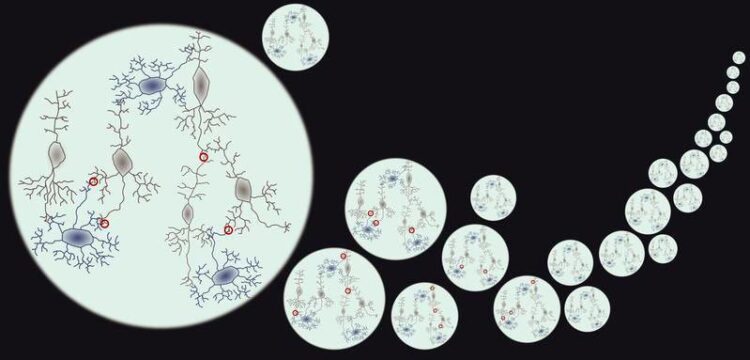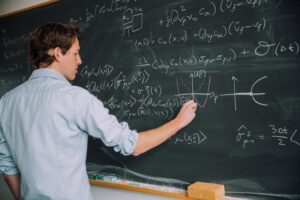High-Risk Research Across Disciplinary Borders

A succession of simulations of biologically realistic neurons with different cell types and realistic morphology. In each iteration of the simulation, only a small number of synapses are allowed to change.
© Maayan Levy
Many problems in modern science require researchers to think beyond the borders of their discipline. Together, neuroscience and computer science investigate how the human brain works and information theory paired with physics might help to shed light on how cells make decisions. However, science is still usually organized into departments and research fields. The NOMIS Fellowship at the Institute of Science and Technology Austria wants to support scientists in bringing disparate fields together.
To draw new connections and gain insights, scientists often need to employ a multidisciplinary approach. This is exactly what the NOMIS Fellowship at the Institute of Science and Technology Austria (ISTA) offers. Established in 2021, this program has been made possible by the partnership between ISTA and the NOMIS Foundation.
Scientists that join this postdoc program are supervised by two experienced group leaders from different fields building a bridge between the teams and bringing together differing perspectives and approaches. They have access to ISTA’s state-of-the-art research facilities, scientific leadership trainings, and career development support. This fully funded three-year position enables the fellows to pursue high-risk ideas that push at the very frontiers of scientific knowledge. Currently, there are four scientists who hold NOMIS Fellowships at ISTA.
Thinking Networks

© Max Hofstetter NOMIS Foundation
One of the NOMIS fellows is Maayan Levy who wants to understand the physical phenomena underlying processes in the human brain like memory formation. Researchers cannot yet simulate the human brain’s tens of billions of neurons and their connections – the synapses – on a computer, but they can use smaller networks to gain insights. Levy is programming virtual networks of about 10,000 neurons with biologically realistic parameters and circuit architecture. These networks help her understand how changes in just a small number of synapses can produce a memory. Similar to traditional neural networks in machine learning, Levy’s networks can be trained to recognize simple images. However, hers are not aimed at network-wide optimization but try to closely mimic real biological functions using only local changes on the level of synapses.
Levy’s work brings together many different fields ranging from neuroscience and biophysics to chemistry and computer science. At this intersection of disciplines she is supported by Tim Vogels from the Computational Neuroscience and Neurotheory group and Peter Jonas from the Cellular Neuroscience group. These two groups bring together their expertise on the physical characteristics and plasticity of cells and machine learning applied to neuronal systems.
Decision-making Cells
Another NOMIS Fellow is David Brückner, who studies the way cells in your body make decisions about where to go and what to develop into. Cells can migrate to heal wounds and fight pathogens. Stem cells can even differentiate into all sorts of cell types. While scientists already understand many of the biological processes involved, the fundamental principles of how cells use complex external inputs to make decisions remain unknown.
To do this, Brückner is looking at large experimental data sets of hundreds of cell movement and develops algorithms to pierce through the noisy movement data. He wants to find the underlying patterns hidden in the data like a needle in the haystack.
Brückner is being supported by Edouard Hannezo from the Physical Principles in Biological Systems group and Gašper Tkačik from the Information Processing in Biological Systems group. These teams investigate, on the one hand, the biomechanics of cells and their movement, and on the other, tackle the problem of understanding biological systems from the perspective of information theory.
Check out our website to learn more about opportunities within the NOMIS Fellowship: https://ist.ac.at/en/education/postdocs/nomis-fellowship/
Media Contact
All latest news from the category: Interdisciplinary Research
News and developments from the field of interdisciplinary research.
Among other topics, you can find stimulating reports and articles related to microsystems, emotions research, futures research and stratospheric research.
Newest articles

A universal framework for spatial biology
SpatialData is a freely accessible tool to unify and integrate data from different omics technologies accounting for spatial information, which can provide holistic insights into health and disease. Biological processes…

How complex biological processes arise
A $20 million grant from the U.S. National Science Foundation (NSF) will support the establishment and operation of the National Synthesis Center for Emergence in the Molecular and Cellular Sciences (NCEMS) at…

Airborne single-photon lidar system achieves high-resolution 3D imaging
Compact, low-power system opens doors for photon-efficient drone and satellite-based environmental monitoring and mapping. Researchers have developed a compact and lightweight single-photon airborne lidar system that can acquire high-resolution 3D…





















